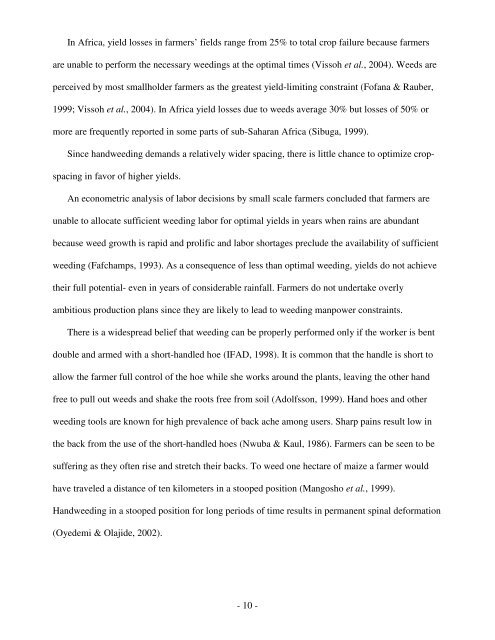solving-africas-weed-problem-report1
solving-africas-weed-problem-report1
solving-africas-weed-problem-report1
Create successful ePaper yourself
Turn your PDF publications into a flip-book with our unique Google optimized e-Paper software.
In Africa, yield losses in farmers’ fields range from 25% to total crop failure because farmers<br />
are unable to perform the necessary <strong>weed</strong>ings at the optimal times (Vissoh et al., 2004). Weeds are<br />
perceived by most smallholder farmers as the greatest yield-limiting constraint (Fofana & Rauber,<br />
1999; Vissoh et al., 2004). In Africa yield losses due to <strong>weed</strong>s average 30% but losses of 50% or<br />
more are frequently reported in some parts of sub-Saharan Africa (Sibuga, 1999).<br />
Since hand<strong>weed</strong>ing demands a relatively wider spacing, there is little chance to optimize cropspacing<br />
in favor of higher yields.<br />
An econometric analysis of labor decisions by small scale farmers concluded that farmers are<br />
unable to allocate sufficient <strong>weed</strong>ing labor for optimal yields in years when rains are abundant<br />
because <strong>weed</strong> growth is rapid and prolific and labor shortages preclude the availability of sufficient<br />
<strong>weed</strong>ing (Fafchamps, 1993). As a consequence of less than optimal <strong>weed</strong>ing, yields do not achieve<br />
their full potential- even in years of considerable rainfall. Farmers do not undertake overly<br />
ambitious production plans since they are likely to lead to <strong>weed</strong>ing manpower constraints.<br />
There is a widespread belief that <strong>weed</strong>ing can be properly performed only if the worker is bent<br />
double and armed with a short-handled hoe (IFAD, 1998). It is common that the handle is short to<br />
allow the farmer full control of the hoe while she works around the plants, leaving the other hand<br />
free to pull out <strong>weed</strong>s and shake the roots free from soil (Adolfsson, 1999). Hand hoes and other<br />
<strong>weed</strong>ing tools are known for high prevalence of back ache among users. Sharp pains result low in<br />
the back from the use of the short-handled hoes (Nwuba & Kaul, 1986). Farmers can be seen to be<br />
suffering as they often rise and stretch their backs. To <strong>weed</strong> one hectare of maize a farmer would<br />
have traveled a distance of ten kilometers in a stooped position (Mangosho et al., 1999).<br />
Hand<strong>weed</strong>ing in a stooped position for long periods of time results in permanent spinal deformation<br />
(Oyedemi & Olajide, 2002).<br />
- 10 -


